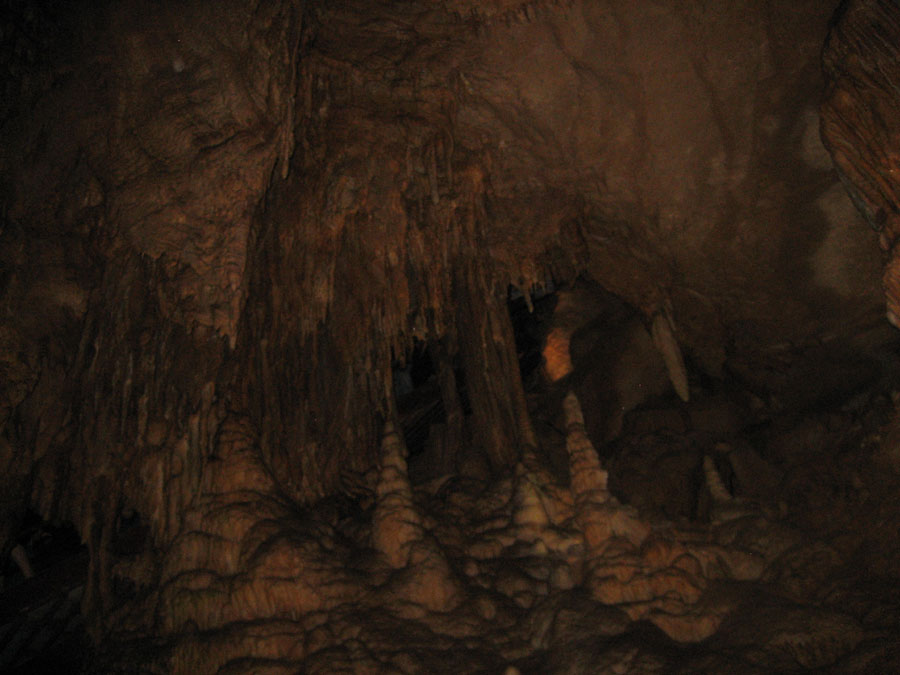 Location Taken: Mammoth Cave National Park, Kentucky
Location Taken: Mammoth Cave National Park, Kentucky
Time Taken: October 2007
Did you know there’s only one section of the massive Mammoth Cave system that is full of stalactites and stalagmites? There’s a few areas that have an occasional one, including a cave system nearby that’s not actually connected to the Mammoth caves that has a nice selection (Great Onyx cave, if you’re wondering.) But for the Mammoth Caves, it’s only the Frozen Niagara section that has these water-based features.
Most of the cave is actually just holes in the rock, without the pointy bits that are in our general stereotype of a cave. It’s because of the very same reason the Mammoth Cave grew so large and extensive in the first place: a hard sandstone cap on top of the limestone the caves wind through.
Water can easily tear through limestone. It’s a porous material, and it just gets in there and rips off bits of the rock like nobody’s business. Sandstone, on the other hand, resists the water. It has a very fine grain to it that leaves very few holes for water to work its way on. The rain falling on these Kentucky hills gets blocked by the sandstone, but any water that works its way through to the limestone has a much easier time.
And the sandstone doesn’t cover all the limestone. To the south of the Mammoth Cave area is a large plain covered with sinkholes. It’s all limestone there, and the water goes there, finds low spots, and makes them lower. And then, once it’s below ground level, it finds its way through various cracks in the rock as it searches for the lowest spot. In this case, it’s the Green River – and that section covered by the sandstone is between the sinkhole plain and the river.
The water coming from the sinkholes doesn’t need to find a way through the sandstone. It’s already in the limestone. It just need to work its way through crack after crack on its path to the river. And the cracks widen, and open up, and more water can fit in to them, and the cracks become caves. Eventually, a new crack will be exposed to the cave that leads the water deeper, and it abandons the old cave for a new series of cracks and caves. Mammoth Cave is on its fourth major layer, and each layer is full of winding caves going this way and that.
And that sandstone cap just sits on top, protecting the upper layers from disappearing like they do in most cave systems that form like this. But the sandstone cap has an edge, and the Frozen Niagara formations are right on it. Here, the sandstone has holes, worn away over the long millenia. And water seeps in to the caves below.
As the water passes through the rock, it picks up minerals from it. Rain water is slightly acidic, and it eats away at the limestone and dissolves it. And when the water reaches the ceilings of the caves below, it finds the lowest spot on the ceiling’s surface, pauses, gathers itself, and falls as a drop before working its way downward once again – leaving some of the dissolved rock behind on the ceiling and the floor below. And that just makes the spot where that drop decided to fall that much more lower than its neighboring rock, encouraging other drops to choose there to fall. Over the ages, those tiny remnants of rock add up to giant amounts, forming a lasting monument to the power of water and time in the form of giant stalactites and stalagmites.
Oh, and if you’re on a cave tour and the guide tells you not to touch the stalagmites, listen to them. Human hands have a fine coating of oil to repel water, and it rubs off on things you touch. Including rocks being formed by the slow dripping of water. The stalagmites will literally stop growing where you touch, as the oil makes the water move too fast to deposit its rocky burden. So really, don’t do it.
